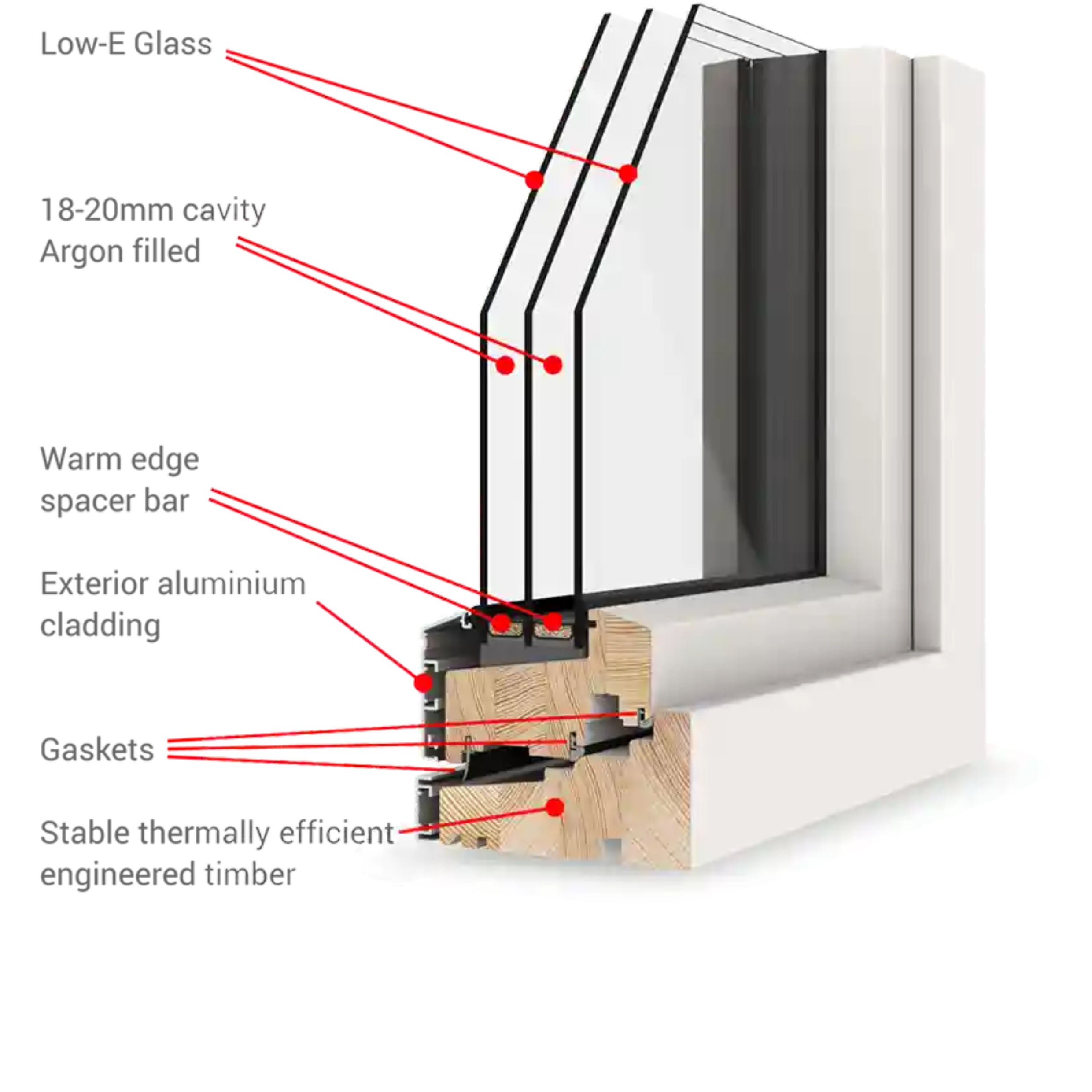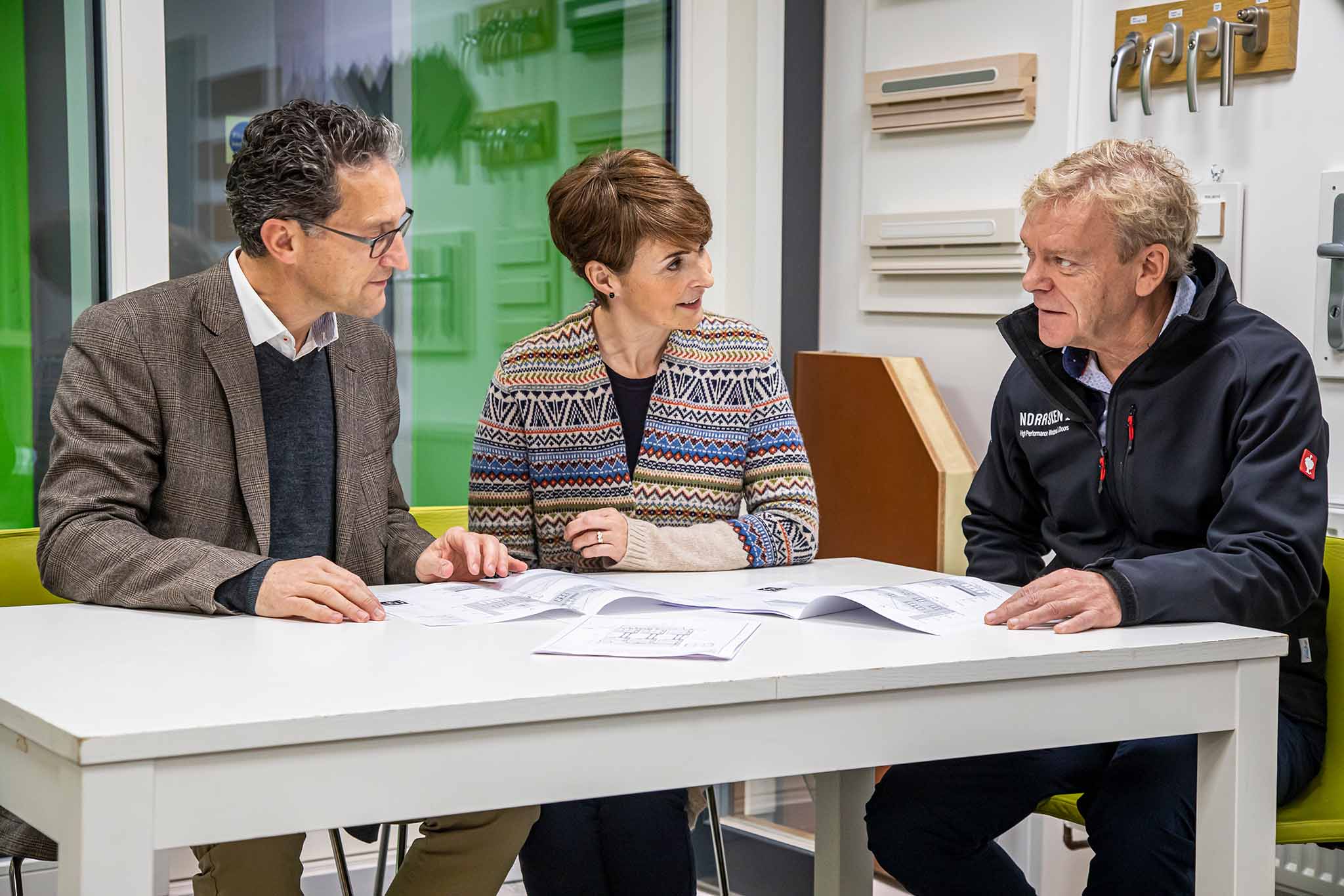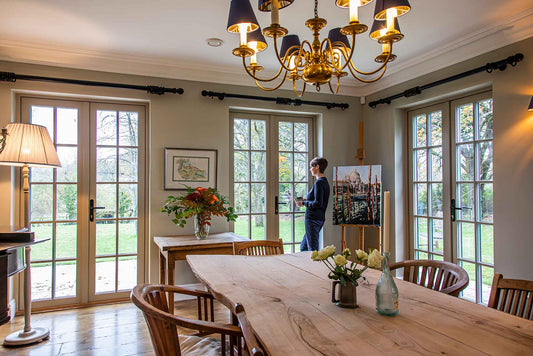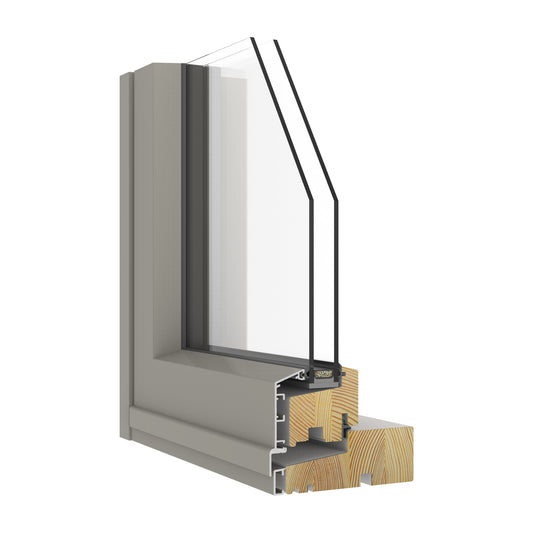
The value of alu-clad timber windows
Choosing the right windows for your home is one of the most important decisions in any building or renovation project.
For homeowners, self-builders, and architects seeking the perfect balance of performance, aesthetics, and longevity, alu-clad windows represent a genuinely transformative solution.
Originally developed to extend the lifespan of traditional timber windows, today's aluminium-clad timber windows deliver far more than enhanced durability. They combine the natural warmth and superior insulation of timber with the weather-resistant strength of aluminium cladding, creating windows that perform exceptionally across every measure that matters.
What are aluminium-clad timber frame windows?
Also known as composite or alu-clad windows, these windows combine engineered timber frames with powder-coated exterior aluminium cladding.
Why alu-clad windows excel
The fundamental advantage of alu-clad windows lies in their composite construction. Timber frames provide exceptional thermal insulation – approximately 800 times more effective than aluminium alone.
This natural insulating property keeps your home comfortable year-round whilst significantly reducing heating costs.
The external aluminium cladding serves as a protective shield, defending the timber core from the UK's challenging weather conditions. This weather-resistant barrier proves particularly valuable in coastal locations, where marine-grade aluminium protects against salt-laden winds and driving rain.
Modern alu-clad windows have evolved significantly from earlier designs. Contemporary manufacturing incorporates sophisticated drainage systems and precision-sealed construction that eliminates historical concerns about moisture infiltration.
These engineering improvements mean today's windows deliver reliable, decades-long performance without the rot issues that affected some older installations.
Collapsible content

Maintenance & Weather Resistance
Unlike traditional timber windows, alu-clad windows require virtually no maintenance.
The timber is protected from the elements by the tough, powder coated aluminium, which only needs to be kept clean. This protection is indispensable, particularly for properties in coastal locations where marine grade aluminium is used.
Thermal Efficiency
The combination of timber and aluminium delivers remarkable insulation performance.
Alu-clad frames combined with triple glazing delivers exceptional whole-window U-values – as low as 0.64.
This translates directly into lower energy bills and a more comfortable living experience year-round.
Sustainability Leaders
Aluminium clad timber windows have lower embodied carbon than equivalent uPVC or all-aluminium frames.
Additionally, the manufacturing processes and waste materials of alu-clad windows are more environmentally friendly than those used for all aluminium or UPVC windows.
Waste timber sawdust is used to heat the factory, while aluminium can be recycled.
Design Freedom
Beyond performance, alu-clad windows offer remarkable design flexibility. The aluminium exterior accepts any RAL colour specification, whilst dual-colour finishes allow different internal and external appearances.
This versatility means windows can present sleek, contemporary lines externally whilst maintaining warm timber aesthetics internally.
The timber frame can be finished with paints, stains, or clear lacquers to complement any interior design scheme. This combination of external durability with internal warmth creates windows that enhance both the exterior appeal and interior character of your home.
Which windows are right for you?
Take our short survey to discover the perfect windows for your project.
Best selling alu-clad windows
-
Outward Opening Alu-Clad Window (P31A)
Regular price £0.01 GBPRegular priceUnit price / per -
Inward Opening Alu-Clad Window (P33A)
Regular price £0.01 GBPRegular priceUnit price / per -
Outward Opening Alu-Clad Window (P41A)
Regular price £0.01 GBPRegular priceUnit price / per -
Outward Opening Alu-Clad Window (P11A)
Regular price £0.01 GBPRegular priceUnit price / per
Inspiration for your project
From heritage transformations to scandinavian-style passive houses, discover how Norrsken windows and doors transform exceptional homes into extraordinary spaces.
Whether it's converting industrial barns into a contemporary sanctuary or pushing the boundaries of sustainable design in passive houses, our projects span every architectural vision. See how our windows and doors brought your Norrsken neighbours' visions to life.
GALLERY
How aluminium-clad timber windows improve energy efficiency
Energy performance stands as one of the most compelling reasons to choose alu-clad windows, delivering measurable benefits that enhance comfort whilst reducing environmental impact.
-
Insulating Timber Core
The timber frame provides exceptional natural insulation, significantly slowing heat transfer between interior and exterior environments. Aluminium cladding protects the window without compromising thermal performance.
-
Advanced Glazing Performance
When paired with high-performance glazing options – such as triple glazing – alu-clad windows achieve U-values as low as 0.64 W/m²K. The practical result? Better heat retention, fewer drafts, and lower heating costs.
-
Advanced Airtightness
Multiple gaskets ensure tight weather seals, eliminating drafts. Our Passive House windows range delivers exceptional airtightness – ideal for low-energy certification.
-
Condensation Control
The insulating timber frame maintains warmer interior surfaces, reducing condensation and preventing moisture-related window issues like mould growth and paint damage.
Understanding composite windows
Aluminium-clad timber windows are an advanced form of composite window construction. The term 'composite' refers to the strategic combination of materialsfor superior performance.
This composite approach delivers hybrid properties that surpass pure aluminium, pure timber, or uPVC windows. Timber provides warmth, character, and outstanding thermal performance. Aluminium contributes durability, weather protection, and minimal maintenance.
Together, they create windows engineered for decades of effortless comfort.
Your questions answered
Have a question? You’re not alone. We’ve answered some of the most common queries about Alu-clad Timber Frame Windows below.
Collapsible content

Are aluminium clad timber frame windows right for you?
If you are looking for windows that deliver enhanced durability, thermal efficiency and stylish aesthetics, with near zero maintenance requirements, then alu-clad windows could be the perfect choice for you.
Are triple-glazed windows right for you?
Alu-clad timber windows can be either double or triple-glazed.
Triple glazing provides homeowners a marked increase – 40-45% - in thermal performance from double-glazed alternatives, meaning greater comfort, lower heating bills, and an uplift in property value.
These windows and doors are durable, secure and aesthetically pleasing - and they're not just for Passive Houses, either.
What are alu-clad windows?
Alu-clad timber windows are made from engineered timber clad externally in powder-coated aluminium cladding.
These windows combine the excellent insulation properties, durability and charm of timber with the low maintenance needs of aluminium. As a result, they are some of the most attractive and best quality products on the market.
Are alu-clad windows more expensive than uPVC or aluminium?
Whilst alu-clad timber windows typically carry higher initial costs than uPVC or basic aluminium options, they deliver superior long-term value through multiple factors.
Their exceptional thermal performance reduces heating costs year after year, whilst their extended lifespan – often twice that of alternatives – eliminates premature replacement expenses.
The minimal maintenance requirements save both time and money over decades of ownership. Additionally, alu-clad windows often increase property values more than cheaper alternatives.
When evaluated on total lifecycle cost rather than initial outlay, alu-clad windows frequently prove the most economical choice.
Are alu-clad windows better than uPVC?
Alu-clad timber windows are much better at insulating - so offer better thermal performance - than most uPVC windows and have a much lower embodied carbon footprint.
They also last longer, have more aesthetic appeal and are more likely to add value to the property, although they tend to cost more. (Source: Researchgate)
Are alu-clad windows better than wood windows?
Aluminium-clad timber windows provide all the same benefits as wood windows - exceptional thermal performance, charming interior style, durability - with the extra benefit of being more weather resistant thanks to the protective layer of aluminium.
However, if traditional style is first priority then timber window frames provide a more classic look.
How much maintenance do aluminium-clad windows require?
Alu-clad timber windows require remarkably little maintenance compared to traditional timber or even some uPVC alternatives.
The powder-coated aluminium exterior never needs repainting – periodic cleaning with mild soapy water maintains its appearance. Internal timber surfaces can be refinished if desired.
Annual lubrication of hinges and moving hardware ensures smooth operation. Compared to all-timber windows requiring regular painting and treatment, or uPVC windows that can discolour over time, alu-clad windows offer genuinely low-maintenance performance throughout their long service life.
Do aluminium-clad timber windows still suffer from rot issues?
Modern aluminium-clad timber windows have evolved significantly from designs produced decades ago.
Contemporary manufacturing incorporates advanced drainage systems, improved timber preservatives, and precision-sealed construction that effectively eliminates historical moisture concerns.
Quality alu-clad windows from reputable manufacturers now routinely achieve 40+ year lifespans, even in the UK's challenging damp climate. The key is selecting windows from manufacturers who employ current engineering standards and quality materials.
What are the benefits of alu-clad windows?
Aluminium clad windows are durable and provide excellent insulation thanks to the timber frames.
The aluminium cladding protects the window from weather damage and decay, ensuring a long lifespan of low-maintenance, dependable performance.
As a result, they are some of the most attractive and best quality windows on the market.
Can aluminium windows be painted?
Our aluminium-clad windows can be finished in any RAL colour with a powder-coated finish.
Dual colour finish - different colours inside and out - is available as standard, so there is no shortage of options when choosing the colour of your windows! Internally the windows can be repainted later if desired.
Are alu-clad better than aluminium windows?
While aluminium frames are strong and light, aluminium is a very poor insulating material - over 1000 times worse than wood.
Even with multi-chambered extrusions and thermal breaks, aluminium still performs much more poorly than timber as a frame material. Aluminium also has higher environmental impacts and higher embodied carbon.
What colours and finishes are available for alu-clad windows?
Alu-clad windows offer exceptional design flexibility through extensive colour and finish options.
The external aluminium cladding can be powder-coated in virtually any RAL colour specification, from classic whites and subtle greys to bold contemporary statements.
Dual-colour finishes allow different internal and external appearances. Internal timber surfaces can be treated with clear lacquers to showcase natural wood grain, stained in various tones, or painted to match interior décor.
This versatility ensures alu-clad windows complement any architectural style, from traditional cottage renovations to contemporary new builds.
Choosing Norrsken isn't just about windows and doors; it's about choosing a partner in your building journey
We supply and install the UK's finest double and triple-glazed alu-clad timber windows and doors. We take pride in exceptional craftsmanship and outstanding customer service – view our reviews on Trustpilot.
From initial consultation to after-sales support, we're here to ensure your complete satisfaction. So ditch the window search blues and embrace a smoother, more streamlined building experience with Norrsken by your side.
Explore our stunning range of alu-clad timber windows and doors today, and discover the Norrsken difference.
-
Alu-Clad Windows
Natural warmth meets modern performance -
Window Selector
Find the perfect windows for your project
Unmistakably trusted.
The highest compliment is a recommendation. These are the voices of those who placed their trust in us.
"Excellent Company from start to finish… If only every window supplier operated like this! I have used many others over the years on various projects but Norrsken far exceeded all of them… I hope this helps you make a decision for what is probably a large chunk of your budget… They are totally worth it"
Angela Smith
Self Builder
“Having used Norrsken in the past we were happy to recommend them to one of our clients who was looking for the best sound proofing and weatherproofing they could get being set on a hill top overlooking the sea and facing strong westerly winds. They were not disappointed. A quality product, delivered well and on time. Thankyou.”
Ken Pearson
Homeowner
"Fantastic professional service, from the original design to the final installation. The triple-glazed windows and doors that have been fitted to our new house are of a very high quality and look amazing. We definitely made the right choice when we decided to use Norrsken, nothing is too much trouble for them."
Nigel
Homeowner
"I did my research before contacting Norrsken but they had come highly recommended by our Architect for our Passive House self build.
From the first meeting with Nick we felt confident that they were the Company for us."
Ali and Brian Manning
Passive House Self Builders
“The quality of the triple glazed, alu-clad windows and doors is superb. They feel so reassuringly solid ... I opted for a wood stain for the internal finish on the frames, and am so glad I did, as it shows off the beauty of the wood perfectly. The whole process from order to installation went smoothly. I thoroughly recommend Norrsken.”
Gareth
Homeowner
"Norrsken provided attentive service from drawings to on-site installation for our project at National Trust Stourhead and we would definitely recommend and repeat commission them on future projects."
Charlotte Hill-Baldwin
Architect, H-B Designs
“From our very first interaction to the aftercare support, Norrsken has been exceptional. The quality of their windows is outstanding - beautifully designed, expertly crafted, and a real standout feature in our home. They've truly elevated the overall look and feel of the house.”
Neil Southwell
Self Builder Homeowner
Related resources
View all-

Triple-Glazing: Is the investment worth it for ...
Lower energy bills, warmer rooms and quieter living. Discover when triple glazing is worth the investment.
Triple-Glazing: Is the investment worth it for ...
Lower energy bills, warmer rooms and quieter living. Discover when triple glazing is worth the investment.
-

The Art of Home
Explore how triple glazing enhances warmth, comfort, and clarity in your home's design.
The Art of Home
Explore how triple glazing enhances warmth, comfort, and clarity in your home's design.
-

Quiet revolution - the power of triple-glazing ...
Discover how triple glazing helps reduce noise pollution and creates peaceful interiors in busy locations.
Quiet revolution - the power of triple-glazing ...
Discover how triple glazing helps reduce noise pollution and creates peaceful interiors in busy locations.
-

The value of alu-clad timber windows
A deep dive into the benefits of alu-clad timber windows: durability, performance, and design.
The value of alu-clad timber windows
A deep dive into the benefits of alu-clad timber windows: durability, performance, and design.














